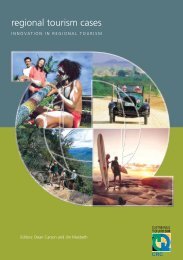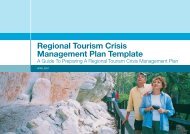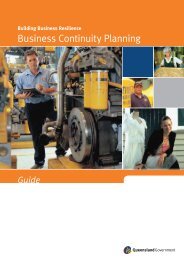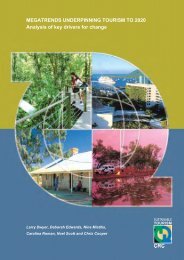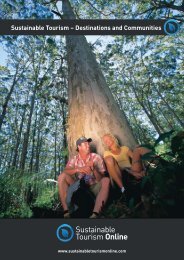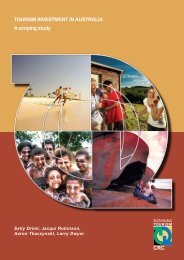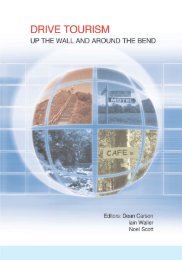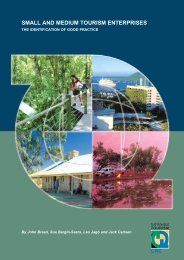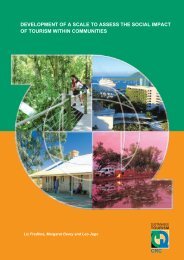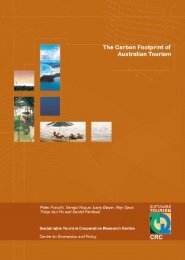Tourism Risk Management - Sustainable Tourism Online
Tourism Risk Management - Sustainable Tourism Online
Tourism Risk Management - Sustainable Tourism Online
Create successful ePaper yourself
Turn your PDF publications into a flip-book with our unique Google optimized e-Paper software.
Proactive Planning: An Example of Best Practice<br />
Although most of the tourism industry would be familiar with cases of poor or inadequate risk<br />
management, it is often considered difficult to find examples of good crisis management planning.<br />
In practice, effective crisis management prevents or minimizes a potential crisis with limited adverse<br />
public or consumer awareness. This implies appropriate measures of mitigation, preparation and<br />
communication. The ideal or “best practice” approach to risk and crisis management is proactive,<br />
strategic and holistic and designed to coordinate and manage a diverse range of tourism<br />
stakeholders.<br />
The essence to achieving such an approach is premised on knowledge, understanding and<br />
familiarity. A valuable and useful strategy for any planning process is to learn from past lessons and<br />
experiences, whether local or international. In their article A case study of best practice—<br />
VisitScotland’s prepared response to an influenza pandemic, Page, Yeoman, Munro, Connell and<br />
Walker (2005) demonstrate how VisitScotland, the Scottish National <strong>Tourism</strong> Organization, used<br />
the incidence of foot-and-mouth disease and systematic scenario planning exercises to develop<br />
proactive contingency plans and response strategies for the looming issue of flu pandemic.<br />
Learning from Foot-and-Mouth<br />
While commonly described as an agricultural, farming or health crisis, the outbreak of foot-andmouth<br />
disease in the United Kingdom had significant impacts on the tourism industry. Consumer<br />
uncertainty and concern led travellers to postpone holidays, cancel trips or choose alternative<br />
destinations. Media images of afflicted livestock, local precautions and stringent travel advices<br />
essentially resulted in reduced tourist numbers and associated revenues. The effect of foot-andmouth<br />
disease on Scotland’s tourism economy was profound, and according to this paper “ensured<br />
that VisitScotland would learn from those experiences for future crises” (p374).<br />
A Potential Flu Pandemic<br />
With growing media attention and awareness dedicated to the spread of Avian Influenza (Bird Flu)<br />
during late 2005, this report outlines how the potential mutation to a global flu pandemic was<br />
identified as a significant issue or external environmental risk likely to impact on the Scottish tourism<br />
industry. Consistent with a systematic risk management process the potential nature, scope and<br />
extent of the issue was researched (in tandem with the Scottish Executive’s Department of Health)<br />
to evaluate the priority of the risk. Determined a high priority issue, scenario planning exercises<br />
were subsequently adapted and developed “to understand the challenges to plan for the type of<br />
actions to prepare for a crisis” (p362).<br />
The Scenario Planning<br />
Based on a variety of realistic scenarios relating to severity and duration, this planning employed a<br />
triangulation of methods to model the diverse implications of an influenza pandemic, including a<br />
quantification of expected disruptions and changes to consumer behaviour. Using established<br />
methodologies, scenarios were developed over a successive period of stakeholder consultation and<br />
iteration. Industry based workshops were then used to further map collective themes and issues to<br />
identify potential outcomes of these scenarios.<br />
The principal outcomes outlined the implications for Scottish tourism relating to issues including;<br />
market reactions and changes, transportation, travel displacement, resources, employment and<br />
staffing, service disruption and civil unrest. From these issues, a number of key or critical issues<br />
were identified to help model anticipated information flow, responsibilities and relevant<br />
stakeholders. Developed as a guide of “principal actions and approach” to the outbreak of a global<br />
pandemic, this exercise has since assisted with tangible contingency planning, business continuity<br />
planning, and the consideration of appropriate response strategies for the Scottish tourism sector.<br />
58 <strong>Tourism</strong> <strong>Risk</strong> <strong>Management</strong> – An Authoritative Guide to Managing Crises in <strong>Tourism</strong>



